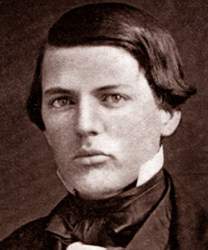Record Data
Source citation
Spencer Fullerton Baird to John James Audubon, June 4, 1840, New York, NY, in Ruthven Deane, "The Unpublished Letters of John James Audubon and Spencer F. Baird," The Auk 23, no. 2 (April 1906), 198-200.
Type
Letter
Date Certainty
Exact
Transcriber
Transcription adapted from "The Unpublished Letters of John James Audubon and Spencer F. Baird," by Ruthven Deane
Adapted by Rebecca Solnit, Dickinson College
Transcription date
Transcription
The following transcript has been adapted from "The Unpublished Letters of John James Audubon and Spencer F. Baird" (1906).
Carlisle, Cumberland Co., Pa., June 4, 1840.
Dear Sir
I herewith send you the description of a species of Tyrannula, an account of which I have been able to find, neither in your Ornithological Biography and Synopsis, not in Nuttall’s Ornithology. I have obtained three specimens, all in low swampy thickets. Two of them I stuffed, the thrid (obtained last Saturday) [May 30, 1840] I have in spirits and would gladly send it to you, had I the opportunity. Their habits were very similar to those of the Little Tyrant Flycatcher. (Muscicapa Pusilla.) Male.
Bill large, depressed, decidely convex in its lateral outlines, and very broad. Third quill longest. Bill dusky above, yellow beneath. Feet dark brown. Upper parts clear greenish olive. Cheeks and sides of neck of a slightly lighter tint. General color of lower parts gamboge yellow, throat slightly darker, across the breast tinged with yellowish green. Quills and tail brown. First row of smaller wing coverts tipped with yellowish white, as also are the secondary coverts. Secondary quills narrowly tipped and margined with the same. Loral space and eyelids yellowish. Outer edge of tail feathers, like the Back. Length to end of tail 5 ½, to end of wings 3, 11.5/12, of claws 4,4.5/12, wing from flexure 2 6/12; tail 2; distance between end of closed wing and end of tail 1 3/12: Bill along ridge 5/12, lower mandible 7/12: Tarsus 7.5/12: Hind toe and claw 4.67/12, middle toe and claw 5.5/12: First quill 4/12 less than third; 3.25/12 less than second. Middle tail feathers 1.5/12 less than the outer. It differs very decidedly from the Little Tyrant Flycatcher. The color of the upper parts is of a much brighter and purer color. The white and ash of the throat, neck, and sides, is replaced by the yellow and greenish yellow. The color of the rest of the lower parts is much brighter, being a decided gamboge. The bill is much larger, and broader, being very decidedly convex in its lateral outlines. The tail also is of a darker brown.
I send you the measurement of another Flycatcher which I shot last Saturday. It was flying about from one low bush to another, in a field by the creek. I heard no note. Length to end of tail 5 3/4, of wings 4 7/12, of claws 3.5/12: extent 9 ½: Tail 2 4.5/12, wing from flexure 3 2.5/12: end of closed wing from end of tail 1 4.5/12: Second quill longer 4.5/12 longer than the first. Middle tail feathers 1.5/12 shorter than outer. Bill along the ridge 5/12, edge of lower mandible 7.5/12 tarsus 6.5/12; Hind toe and claw 4/12; middle toe and claw 5.5/12.
This bird was a female, and resembled the Wood Pewee very much having the same large and broad bill, and pretty much the same claws. It may be a very small individual of that species.
You see Sir that I have taken (after much hesitation) the liberty of writing to you. I am but a boy, and very inexperienced, as you no doubt will observe from my description of the Flycatcher. My brother last year commenced the study of our Birds, and after some months I joined him. He has gone elsewhere to settle and I am left alone. I have been much assisted however by Mr. A. Foster of this place in various ways, and should the above Flycatcher happen not to have been described, it would gratify me very much to have it honored with his name. This letter is already too long, yet perhaps you will pardon me for adding a few remarks about some of the Birds found about Carlislse. And first, has not the adult male Cape May warbler a black crown? I obtained three specimens this spring, two of which agree with you description, while the third resembles the other two perfectly, except in having a perfectly black crown, as stated by Nuttal.
The Little Tyrant Flycatchers (M. Pusilla) were very abundand here this spring. I found them principaly on low bushes and trees, in wet places, and I have seen more than a dozen in a day.
The Rough winged swallow is very abundant about here. In fact I may say to the exclusion of the Common Bank Swallow, as I have in vain this spring endeavored to get a specimen of the latter. They breed in the banks along the Letort spring.
I procured a singular variety of the Ruby crowned Regulus this spring. It has a patch of whitish feathers on the forehead.
I have already tresspassed to much on your patience, and will conclude by saying, that if I can be of the slightest assistance to you in any way, by assured that although others may tendr it more ably, yet none can more cheerfully.
I am Sir, very Respectfully
Your Obedient Servant
Spencer F. Baird
J.J. Audubon. F.R.S. &c.
86 White Street, New York



